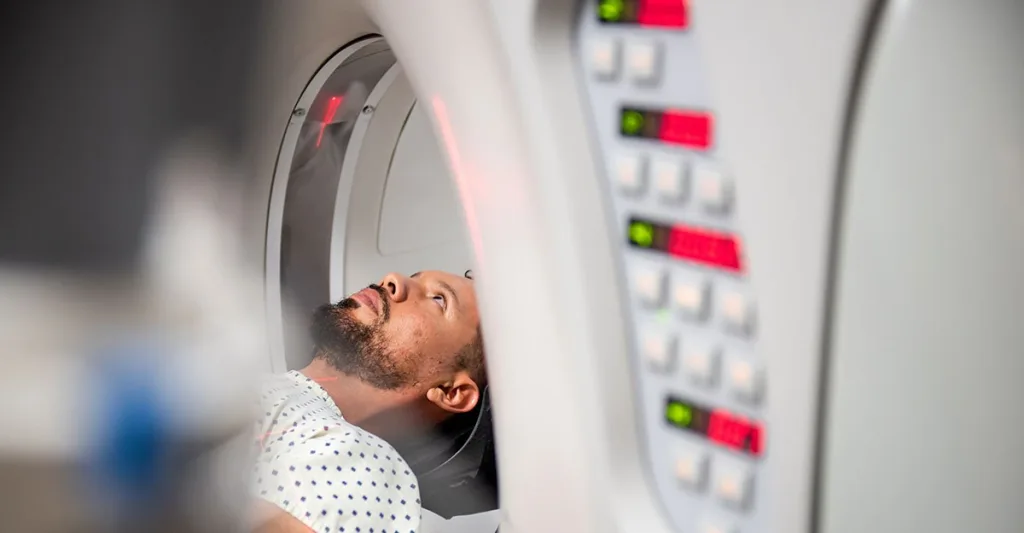In radiology care, two essential roles contribute significantly to successful imaging procedures: The radiology nurse and the radiologic technologist.
While both professionals collaborate closely, their responsibilities, education, and skill sets differ in important ways.
Here we explore key differences in the radiology nurse and radiologic technologist roles.
1. Education and training
Educational paths and training requirements for radiology nurses and radiologic technologists differ significantly. This reflects the distinct nature of their roles.
Education for radiology nurses
After obtaining an RN license, nurses who are interested in radiology typically obtain additional certifications in radiology nursing (such as the Certified Radiology Nurse (CRN) credential offered by the Radiologic Nursing Certification Board). This certification requires a certain amount of experience in radiology nursing. Nurses must pass an exam covering patient care, imaging modalities, and radiology procedures.
Education for radiologic technologists
The first step is to obtain an associate’s degree in radiologic technology. The curriculum covers anatomy, physiology, patient care, radiation physics, and imaging principles, along with hands-on clinical experience. Next, radiologic technologists must take and pass a certification exam administered by the American Registry of Radiologic Technologists (ARRT). This certification is required in most states to practice as a radiologic technologist. Some individuals choose to specialize further with additional certification in MRI, CT, mammography, or interventional radiography (IR).
2. Scope of practice
A radiology nurse has a broad scope of practice covering various aspects of patient care, including:
- Patient assessment: Pre-procedure, a radiology nurse evaluates a patient’s medical history, current health condition, and prospective risks associated with the imaging procedure.
- Patient education: Nurses inform patients and families on what the procedure entails, any necessary preparations, and aftercare.
- IV and medication administration: A radiology nurse starts IV lines, administers contrast agents, and monitors patients for adverse reactions.
- Monitoring and sedation: During imaging procedures, especially those involving sedation or anesthesia, a radiology nurse observes vital signs, level of consciousness, and overall well-being of the patient. Nurses are trained to recognize and respond to any complications or emergencies that arise.
- Assisting with interventional procedures: In IR, radiology nurses assist with angiography, biopsies, and catheter placements.
- Post-procedure care: The radiology nurse monitors patients for complications, manages pain, and provides discharge instructions.
A radiologic technologist focuses primarily on the technical aspects of imaging procedures. Their responsibilities include:
- Operating imaging equipment, including X-rays, CTs, MRIs, and mammography units: The technologist positions patients correctly to obtain the best possible images, and ensures that the equipment functions properly.
- Patient preparation: Radiologic technologists explain the procedure, position the patient on the examination table, and apply any necessary protective measures (such as lead aprons) to minimize radiation exposure.
- Image acquisition: Technologists are skilled in capturing high-quality images that are essential for making an accurate diagnosis. This entails adjusting equipment settings and selecting the appropriate imaging techniques based on the patient’s state of health and the clinical question.
- Radiation safety, for both patients and staff: The technologist follows established protocols to minimize exposure, using protective equipment and maintaining and calibrating imaging devices.
- Image processing and evaluation: After capturing the images, the technologist processes them using digital systems. Radiologic technologists perform initial evaluations to be sure images meet required diagnostic standards, before forwarding them to the radiologist for interpretation.
3. Patient interaction
Both radiology nurses and radiologic technologists interact with patients, but the nature and depth of these interactions differ. A radiology nurse interacts with patients in a more sustained, holistic way. In contrast, radiologic technologists interact with patients in a more limited way, mainly during the imaging procedure itself.
Patient interaction for a radiology nurse involves:
- Holistic care: The radiology nurse considers the patient’s overall well-being, and addresses physical, emotional, and psychological needs.
- Advocacy: A radiology nurse ensures that patient concerns are heard and addressed. Nurses create a calming environment, especially for patients who are anxious or fearful.
- Continuity of care: A radiology nurse is a consistent point of contact for patients throughout radiology care.
Patient interaction for a radiologic technologist involves:
- Explaining the procedure: Technologists inform patients what to expect and give specific instructions to follow during the exam.
- Patient positioning: Technologists position the patient correctly on the examination table to obtain the best possible images.
- Ensuring comfort: Technologists ensure patients are as comfortable as possible during the procedure, adjusting positioning or equipment as needed.
4. Collaboration and teamwork
Both radiology nurses and radiologic technologists work closely with other healthcare professionals. The roles differ in who they collaborate with, and to what extent.
A radiology nurse:
- Works closely with radiologists during procedures, providing patient care and Assisting with the technical aspects of the procedure
- Coordinates with anesthesiologists (in cases requiring sedation or anesthesia) to ensure the patient’s safety and comfort
- Coordinates care with other nurses when patients are transferred from inpatient units or require follow-up care after an imaging procedure
A radiologic technologist:
- Works under the supervision of radiologists, ensuring that the images captured are of high quality
- Coordinates with nurses to ensure patients are prepared for imaging. This is especially important when sedation is involved
- Interacts with referring physicians or specialists to clarify imaging requirements, or to discuss specifics of a patient’s condition
5. Career advancement and specialization
Both radiology nurses and radiologic technologists have opportunities for career advancement and specialization. However, the paths they take differ.
Radiology nurses can advance their careers through:
- Certification and specialization: Obtaining certification, such as a Certified Radiology Nurse (CRN) can open doors to more specialized roles.
- Advanced practice roles: An experienced radiology nurse may pursue advanced practice roles such as a nurse practitioner (NP) or clinical nurse specialist (CNS) with a focus on radiology or IR.
- Leadership positions: Nurses can move into roles, such as radiology nurse manager or director of radiology services, overseeing nursing staff and managing departmental operations.
Radiologic technologists can advance their careers through:
- Specializing in advanced modalities: Gaining specific expertise in MRI, CT, mammography, or IR can lead to higher pay and increased responsibilities.
- Certification in specific imaging techniques: These can enhance a technologist’s qualifications and career prospects.
- Supervisory and educational roles: An experienced technologist can manage other technologists, or become educators, training the next generation of radiologic technologists.
How these roles emphasize teamwork in radiology care
Both radiology nurse and radiologic technologist roles require specialized education and training, and both offer opportunities for specialization and advancement. The roles differ in important ways, however.
Overall, radiologic technologists are responsible for the technical aspects of capturing high-quality images. In contrast, a radiology nurse focuses more broadly on patient care and safety before, during, and after imaging procedures.
Understanding how these roles differ highlights the diversity of careers in radiology. It also underscores the importance of teamwork in radiology care, with professionals collaborating to ensure accurate diagnoses and patient safety.
Whether you're actively seeking a new role or assessing your next steps, explore Nurse.com's talent marketplace to help match your experience and skills to the best-fitting role.








